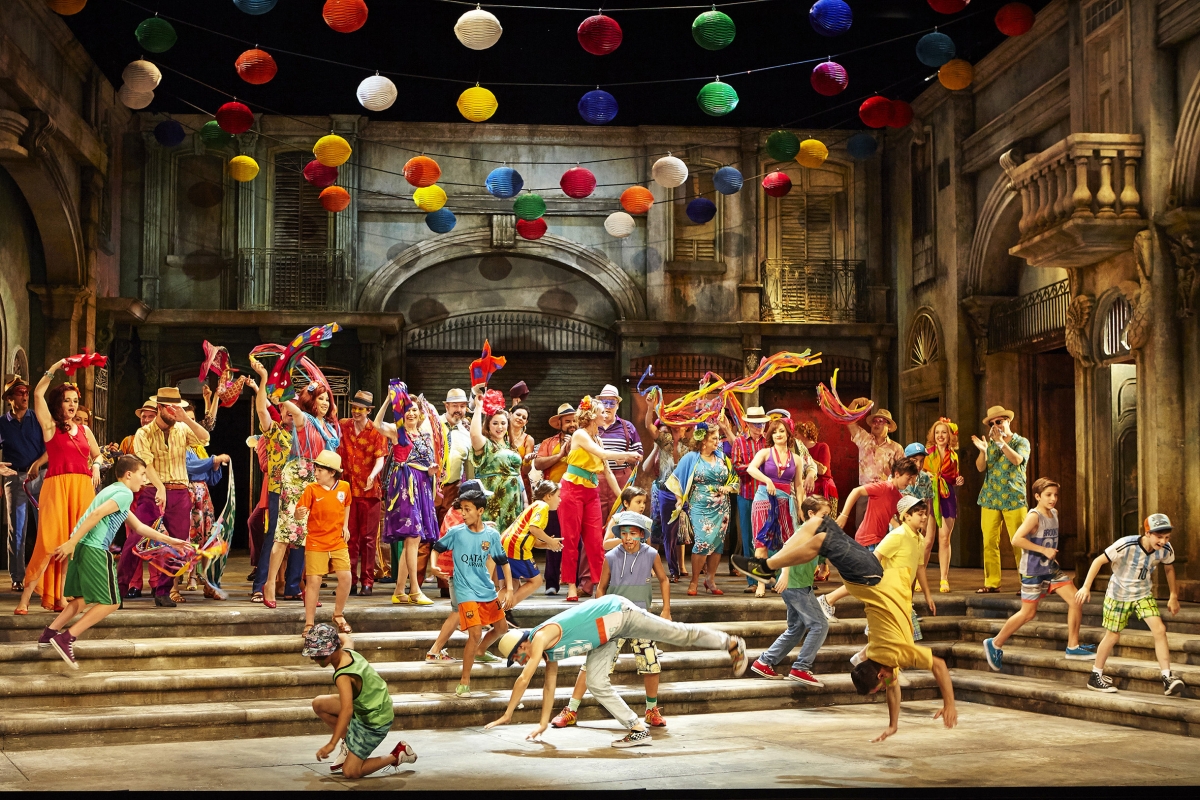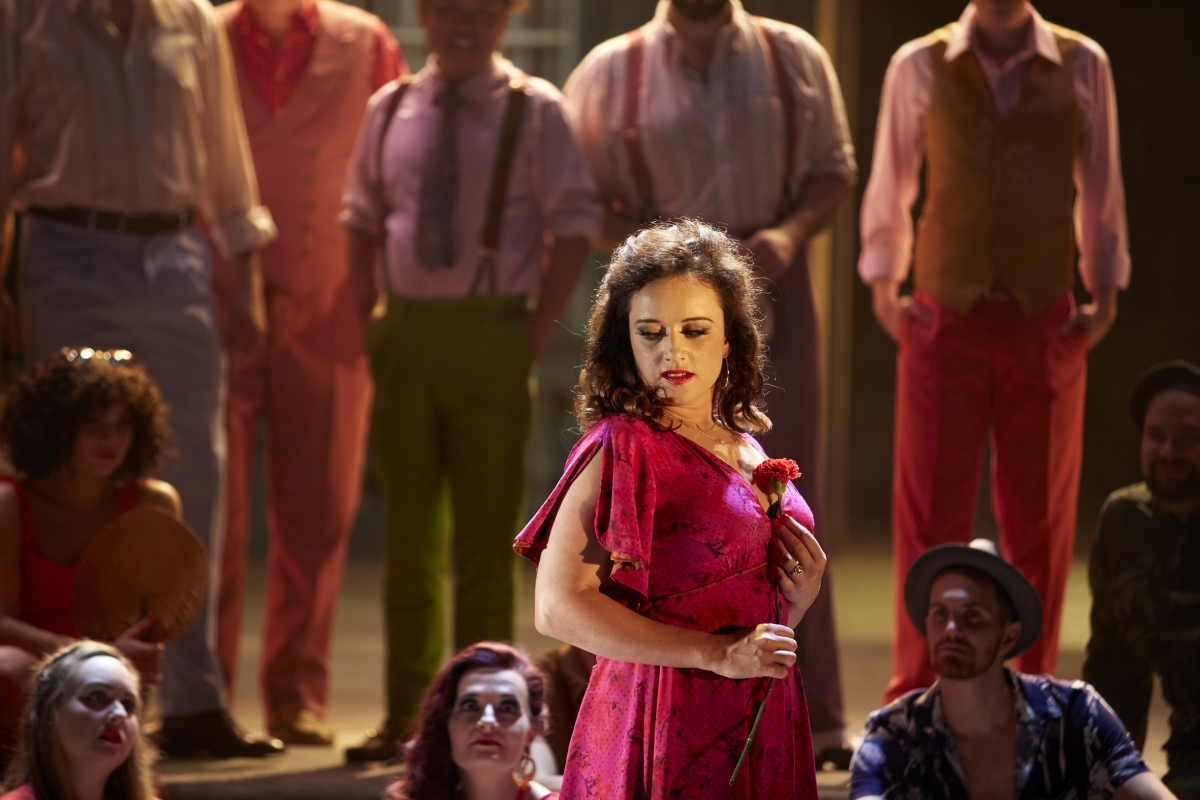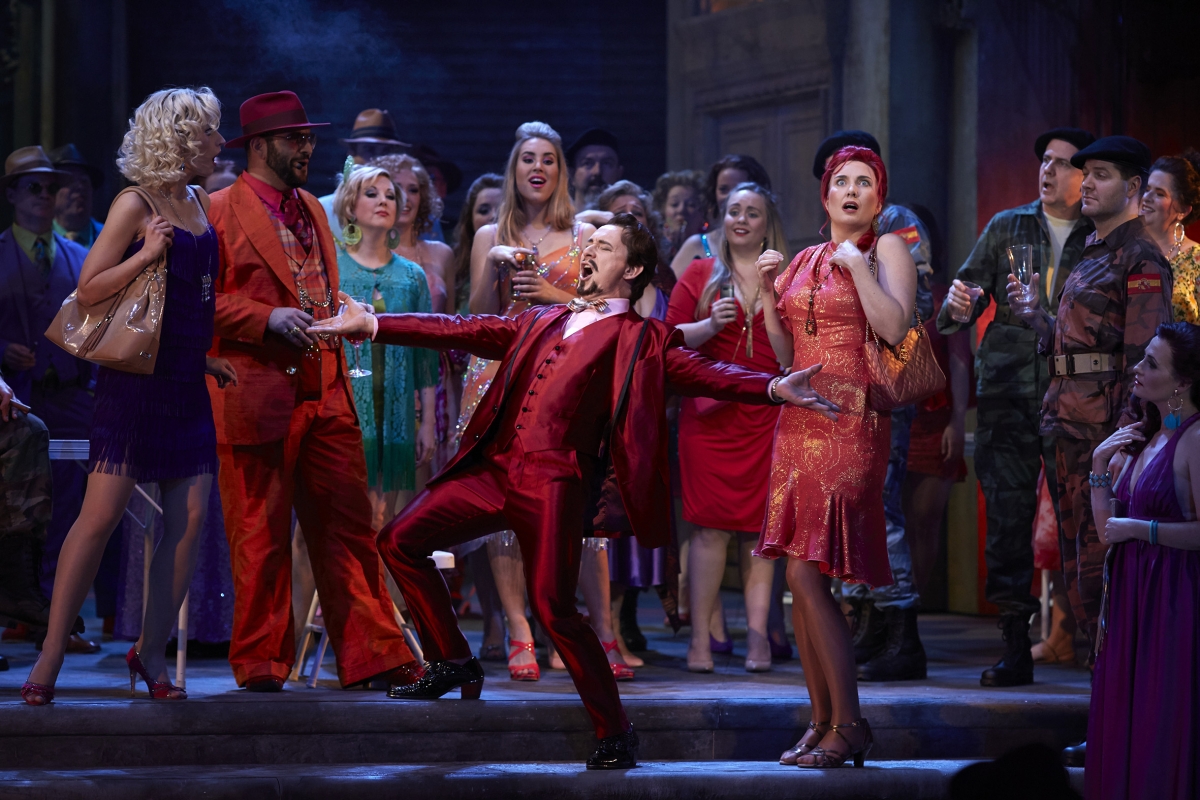★★★★☆ John Bell’s ‘Cuban’ take on Bizet offers a lot to sing and dance about.
Joan Sutherland Theatre, Sydney Opera House
June 16, 2016
Unlike Goethe’s Faust, which gets regular translations into English and is still widely studied, Prosper Mérimée’s Carmen belongs to the canon of operas based on romantic novellas that no one nowadays has ever really read – works like John Luther Long’s Madame Butterfly or Scènes de la Vie de Bohème by Henri Murger. In the original novella, Don José is a gambler, thief and vicious thug who has killed and will kill again, in particular despatching Carmen’s husband in a knife fight, before marrying her himself. A relationship ripe for exploration and reassessment then, and the focus of John Bell’s colourful, energetic and largely successful new staging for Opera Australia – their third production of Carmen in as many years.
As in many of his successful Shakespeare stagings, Bell has opted for a contemporary setting, in this case a country something like (but not exactly) Cuba. Although that gives him access to mod cons like Michaëla’s carry-on hand luggage and plenty of cell phones, the retro atmosphere of a city like Havana means he can offer sops to the ‘modern staging averse’ with plenty of nods to timeless fashion and furnishings. In this he’s ably abetted by Michael Scott-Mitchell’s monumental plaza, all sun-soaked burnished stone and crumbling balconies, where every detail reeks of stylish decay and every window blind is missing at least a couple of slats. Teresa Negroponte’s vibrant costumes complement the washed-out architecture and peeling walls with a riot of colour, though occasionally tending towards the garish and in need of a bit more visible wear and tear.

Opera Australia’s production of Carmen © Keith Saunders
Bell’s steamy plaza provides a convincing location for a grubby world of crooks, pimps and whores who mingle and with the local military presence – a lazy, semi-dodgy soldiery that prefers to loll around on steps and only stands if it absolutely has to. The first act could benefit from a bit more coming and going (“Sur la place, chacun passe” pretty much refers to just the one person), but Lillas Pastia’s clapped-out mobile snack shack in act two is an inspired touch as are the lights conspicuously on in apartments in act three suggesting a populace who turn the blindest of eyes to the ton of contraband (arms, furs and drugs) regularly passing beneath their windows. Elsewhere, Carmen and José’s wedding complete with selfies is a nice nod to Mérimée, while the focus on Zuniga as the hapless military head honcho gives the first half a clear dramatic focus.
Of course, Carmen would never fly without a convincing reading of the dysfunctional central relationship – “that terrible dance of death,” as Bell described it to me in an interview last week. Here, the director’s sure hand charts a clear path from ambivalence to obsession, helped by convincing performances by his two lead actors. Clémentine Margaine’s Carmen chooses José precisely because he pays her no attention. As her lover, Yonghoon Lee ably conveys a sense of mounting arousal while signalling an awareness of Carmen as forbidden fruit. His childlike collapse at the end of the Flower Song exposes an intriguing mother-figure complex, and Carmen’s ultimate rejection of such an infantile gesture speaks equal volumes. Not unsurprisingly, the visceral final scene is the opera’s appropriate climax.
One interesting directorial choice is the prominence given to Kelley Abbey’s excellent choreography. There’s a strong feel of musical theatre here in the regular recourse to dance, and if professional dancers put alongside an opera chorus doesn’t always feel fully integrated, in other places it injects a great sense of fun. The urchins (here a gang of streetwise boys) burst with energy and their gymnastics and body-popping moves are a joy. The act three quintet is also excellent, thanks to fine physical turns from the smugglers and their molls.

Clémentine Margaine © Keith Saunders
Making her Opera Australia debut, French mezzo Margaine is a rising star who brings the perfect combination of musicality and physical voluptuousness to the central role of femme fatale. Her honeyed tone easily extends over the full range and her imaginative use of text and dynamics helps a fully rounded character leap into life. Her authentic Gallic pronunciation revels in the occasional pungency of a nasal vowel-sound, while her physicality conveys an equal measure of Spanish passion. Essaying textbook readings of the Habanera and Seguidilla, she’s also outstanding in ensemble and blends sensitively in duet.
I’d describe Yonghoon Lee’s Don José as a work in progress. Dramatically convincing, his dark-hued tone isn’t what would be generally be regarded as a French tenor sound and there are some odd vowel sounds in the lower register. As a result, his high lyrical singing lacks a certain effortlessness and his French is idiosyncratic much of the time. Nevertheless, at the top, and especially when called upon to sing out, he is often thrilling, the voice secure and capable of eye-popping powers of projection. His warm characterisation is more sympathetic than many Josés, playing more of the emotional introvert than the suppressed psychopath. In other words, he comes across of less of the volatile whinger while creating a convincing character arc.
The two protagonists are well matched by Natalie Aroyan’s winning Michaëla, singing with an attractive clean, clear tone and comfortable at the top in her deceptively tricky aria. Her characterisation has a simple truthfulness that’s entirely convincing. Michael Honeyman’s Escamillo, on the other hand, is more problematic. A committed actor, he’s hampered by being dressed like an Edwardian dandy and he’s short on the vocal or physical stature to fully convince as a red-hot lover. Vocally he’s reliable, but had some flat moments on opening night with the high-lying melodies in the Toreador’s Song.

Margaret Trubiano, Michael Honeyman and Jane Ede © Keith Saunders
The smaller roles are all well taken. Kanen Breen and Luke Gabbedy’s spivvy smugglers were oily delights, well matched dramatically by Jane Ede’s purple-beehived Frasquita and Margaret Trubiano’s fur-coat-no-knickers Mercédès. All four sang with clarity and focus. Adrian Tamburini’s Zuniga was given a better character arc than in previous productions, which allowed him to shine dramatically as well as vocally. Christopher Hiller made a warm, slightly rueful Moralès.
Andrea Molino is a dynamo in the pit, powering things forward from the vigorous overture onwards, yet unafraid to be appropriately bold with rubato when required. He brings out plenty of colour in Bizet’s extraordinary score, the intermezzos with their various delicious woodwind solos a highlight. The chorus embrace a directorial decision to give then plenty of head and a variety of personalities, while singing with their usual power and precision. The first-rate boys chorus sang with more confidence than the last time I saw Carmen. The prelude to the bullfight was a blast, both vocally but also for the sense of dramatic colour and excitement and proving that with a bit of imagination it can be done without horses or fireworks.
The opening night felt a little in need of another run to settle down, but it will be fascinating to see how this intriguing and energetic staging beds in. Well worth a look for all sorts of reasons, not least of which are Clémentine Margaine and Bell’s insightful direction.
Opera Australia’s Carmen plays at Sydney Opera House until August 12












Comments
Log in to join the conversation.